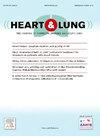Association between exposure to a mixture of dichlorophenol and parabens and lung function in adults from NHANES, 2007–2012
IF 2.6
4区 医学
Q2 CARDIAC & CARDIOVASCULAR SYSTEMS
引用次数: 0
Abstract
Background
Few studies have examined the effects of dichlorophenol and parabens on lung function, with most focusing on individual chemicals.
Objectives
This study analyzes the effects of these chemicals on single or mixed exposures on lung function in adults.
Methods
We utilized data from the 2007–2012 National Health and Nutrition Examination Survey (NHANES), focusing on urinary levels of dichlorophenol, parabens, and lung function measures. The generalized linear regression (GLM), weighted quantile sum (WQS) regression, and Bayesian kernel machine regression (BKMR) models were applied to assess the impact of chemical exposure on lung function.
Results
A total of 2,599 adults with complete data were included in the analysis. Detection rates exceeding 75 % for 2,5-Dichlorophenol (2,5-DCP), 2,4-Dichlorophenol (2,4-DCP), methyl paraben, and propyl paraben were observed. In GLMs, 2,5-DCP was significantly negatively associated with forced vital capacity (FVC) and forced expiratory volume in 1 s (FEV1), either as a continuous (FVC: β = −0.012, 95 % CI = −0.018, −0.006; FEV1: β = −0.010, 95 % CI = −0.017, −0.004) or quartile variable (FVC: β = −0.027, 95 % CI = −0.039, −0.016; FEV1: β = −0.024, 95 % CI = −0.036, −0.011). The WQS regression confirmed a negative effect of the chemical mixture on lung function, with significant associations for both FVC (β = −0.013, 95 % CI = −0.018, −0.008) and FEV1 (β = −0.013, 95 % CI = −0.017, −0.007). These results were consistent in BKMR models.
Conclusion
Exposure to dichlorophenol and parabens, either individually or in combination, is associated with decreased lung function in humans.

2007-2012年NHANES公布的成人接触二氯酚和对羟基苯甲酸酯混合物与肺功能之间的关系
很少有研究考察二氯酚和对羟基苯甲酸酯对肺功能的影响,大多数研究集中在单个化学物质上。目的分析单次或混合接触这些化学物质对成人肺功能的影响。方法利用2007-2012年全国健康与营养调查(NHANES)的数据,重点关注尿中二氯酚、对羟基苯甲酸酯和肺功能的水平。应用广义线性回归(GLM)、加权分位数和(WQS)回归和贝叶斯核机回归(BKMR)模型评估化学物质暴露对肺功能的影响。结果共纳入资料完整的成人2599例。2,5-二氯酚(2,5- dcp)、2,4-二氯酚(2,4- dcp)、对羟基苯甲酸甲酯和对羟基苯甲酸丙酯的检出率超过75%。在GLMs中,2,5- dcp与1 s内用力肺活量(FVC)和用力呼气量(FEV1)呈显著负相关,无论是连续(FVC: β = - 0.012, 95% CI = - 0.018, - 0.006;FEV1: β = - 0.010, 95% CI = - 0.017, - 0.004)或四分位数变量(FVC: β = - 0.027, 95% CI = - 0.039, - 0.016;Fev1: β =−0.024,95% ci =−0.036,−0.011)。WQS回归证实了化学混合物对肺功能的负面影响,与FVC (β = - 0.013, 95% CI = - 0.018, - 0.008)和FEV1 (β = - 0.013, 95% CI = - 0.017, - 0.007)均有显著相关。这些结果与BKMR模型一致。结论二氯酚和对羟基苯甲酸酯单独或联合暴露与人体肺功能下降有关。
本文章由计算机程序翻译,如有差异,请以英文原文为准。
求助全文
约1分钟内获得全文
求助全文
来源期刊

Heart & Lung
医学-呼吸系统
CiteScore
4.60
自引率
3.60%
发文量
184
审稿时长
35 days
期刊介绍:
Heart & Lung: The Journal of Cardiopulmonary and Acute Care, the official publication of The American Association of Heart Failure Nurses, presents original, peer-reviewed articles on techniques, advances, investigations, and observations related to the care of patients with acute and critical illness and patients with chronic cardiac or pulmonary disorders.
The Journal''s acute care articles focus on the care of hospitalized patients, including those in the critical and acute care settings. Because most patients who are hospitalized in acute and critical care settings have chronic conditions, we are also interested in the chronically critically ill, the care of patients with chronic cardiopulmonary disorders, their rehabilitation, and disease prevention. The Journal''s heart failure articles focus on all aspects of the care of patients with this condition. Manuscripts that are relevant to populations across the human lifespan are welcome.
 求助内容:
求助内容: 应助结果提醒方式:
应助结果提醒方式:


